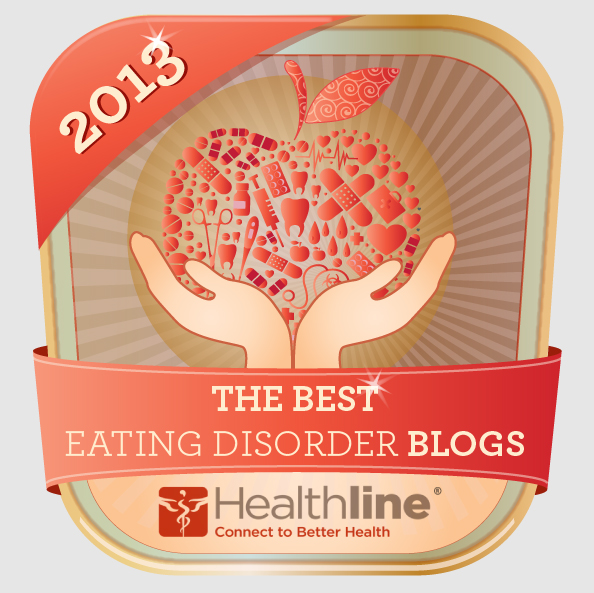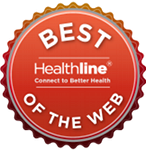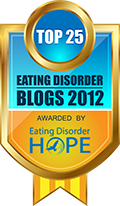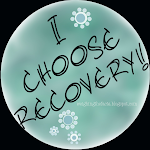Showing posts with label eating disorders information. Show all posts
Showing posts with label eating disorders information. Show all posts
Eating Disorders News and Views: August 8 2012
Warning: Articles may be triggering.
articles do not necessarily reflect the views of this blog
FAMILY HEALTH MATTERS: Eating disorders a concern for not only teenage girls
Eating disorders describe several serious conditions that affect 24 million Americans each year, according to the Renfrew Center Foundation for Eating Disorders. And, it’s not always those you would expect.
Boys, adult women and men are not immune from developing this life-threatening condition, either. In fact, according to the National Association for Anorexia Nervosa and Associated Disorders, 10 to 15 percent of individuals suffering from anorexia are male.
Eating disorders fall under several categories, the most widely publicized, and dangerous of which are anorexia (severe food restriction) and bulimia (consuming and vomiting large amounts of food). Binge eating (excessive eating without vomiting) and excessive exercise are also considered eating disorders.
Read Family Health Matters in full
Anorexia’s scary online empire
Nothing tastes as good as blogging feels
Once upon a time, anorexia was a relatively private matter. The person suffering from it usually denied their affliction to avoid treatment. Most often, it would remain a secret once diagnosed, in part to avoid becoming the subject of local gossip. And once detected, the person in question would undergo treatment and find herself sequestered away from the outside world in a hospital that wouldn’t even allow Barbie or Disney princess paraphernalia to infiltrate its walls, lest it trigger her urge to starve. Hopefully, she would recover. She would go on with her life, and her friends and family would encourage her to eat, maybe relax a little. Her once-secret eating disorder would become something that she had overcome. It was possible that she would even write a memoir about it one day; Wasted; Solitaire; Feeling for the Bones; Thin; I could name at least a dozen that aren’t about eating disorders, but simply memoirs of a troubled life involving starving yourself at one point in a longer line of suffering.
Read Online Empire in full
Young with eating disorders 'missing out on vital help'
Eating disorders in children are not being taken seriously enough, depriving them of vital treatment, a leading expert has told BBC Newsnight.
Professor Bryan Lask said he is seeing ever younger patients, with increasing numbers becoming ill under age 10.
His pioneering research suggests a strong genetic predisposition to anorexia, which experts say needs to be tackled through early intervention.
New figures reveal eating disorders cost the NHS £1.26bn a year in England.
Read Young with EDs in full
Young, beautiful, anorexic and dead
AT 19, with several teen magazine cover shoots behind her and the prospect of a lucrative modelling career, Bethaney Wallace faced a crippling struggle with eating disorders which finally claimed her life this year.
Doctors believe that over the three years since she developed anorexia and bulimia, her condition had weakened her heart and it stopped beating as she slept.
Her father said: "She lost her self-esteem. She would say she was fat but she was so beautiful -- she didn't realise how beautiful she was.
"She had up days and down days. It was like Jekyll and Hyde.
"I tried to warn her that her organs would fail but she just said: 'Don't be silly'. If you mentioned food it would start an argument."
Read YBA&D in full
Eating disorders exact a toll on older women, too
Molly Woolsey was 19 when her anorexia was diagnosed. Once she passed her 20s, the St. Paul woman said, passers-by assumed she had cancer or another terminal illness because she was so thin.
“It doesn’t occur to them that someone my age could have an eating disorder,” said Woolsey, now 45.
Advertisement
Anorexia, binge eating and bulimia are considered afflictions of teenage girls or women in their 20s. But increasingly, older women are admitting to eating disorder symptoms, which put them at higher risk for a wide range of health problems.
Read Toll on Older Women in full
The pressure to be everything
In the recent Wenatchee World article about eating disorders, nutritionist Laurie Kutrich noted that she has seen an increase in patients with anorexia and bulimia. In October 2010, The Guardian reported a significant increase in prevalence of eating disorders seen in women ages 30 and above. I believe we need to look beyond conventional explanations for the rise in eating disorders and consider ways that the economic downturn may be increasing these illnesses in our society and community. The slow economy creates pressure on women to become an “equal or greater” breadwinner in the family unit (in addition to fulfilling all the other more traditional female roles).
Read Everything in full.
Great Majority of Women with Eating Disorders are Vegetarians
A new study published in the Journal of the Academy of Nutrition and Dietetics has determined that women diagnosed with an eating disorder are four times more likely to be vegetarian compared to women with no eating disorders.
In addition to this, women with a diagnosed eating disorder were twice as likely to have been vegetarian at some point in their lives, compared to women without eating disorders.
Read Great Majority in full.
Eating Disorders Tied to Drug Use, Drinking
Adolescent girls with a variety of eating disorders -- even conditions less severe than anorexia or bulimia -- are at risk for obesity and alcohol and drug use, a prospective study found.
Among those who reported binge eating but not purging, the risk for becoming overweight or obese was doubled (OR 1.90, 95% CI 1.04 to 3.48) compared with healthy peers, according to Alison E. Field, ScD, of Harvard University in Boston, and colleagues.
Read Tied To in full
.
If you liked this post please take a moment to share it:
Labels:
anorexia news,
bulimia news,
eating disorders information,
eating disorders news,
eating disorders recovery news,
ED news,
EDNOS news
SED: Selective Eating Disorder Revisited
Selective Eating Disorder may also be known as SED, picky eating, fussy eating, food phobia, selective eating, or perseverative feeding disorder.
SED is not listed as an official eating disorder in the DSM
SED is common in young people with autistic spectrum disorders, this is likely caused by Sensory Integration Dysfunction. It is also found with other special needs adolescents. It is commonly accompanied with severe refusal behaviors when non-preferred foods are presented. SED can be caused by an extra sensitive taste sensation caused by more Fungiform papilla than average, this is the most common cause of SED. It is also found in people with Obsessive Compulsive Disorder. People with the Autoimmune disorder Coeliac Disease are often picky eaters.
Wikipedia
Selective Eating Disorder affects both children and adults.
The cause of SED is unknown.
Contributing factors may include:
- early negative food association
- negative food experiences (such as; choking, acid reflux, gastrointestinal troubles)
- problem behaviors
- negative behaviors learned at the dinner table
- ASD
- Anxiety Disorder
- OCD (mild form)
One theory suggest that those with SED are 'super tasters,' who taste food more intensely than others.
It is unknown how many adults suffer from SED as most who suffer from this disorder go to great lengths to hide it. You can help by filling out this survey at Duke.
Typically, though food choices vary per person, foods deemed acceptable by many with SED are usually bland, refined foods, high in carbohydrates and, for some, on the salty side. Many with selective eating disorder deem foods such as french fries, cheese pizza, pasta, and often chicken fingers as acceptable.
Symptoms may include:
- an aversion to certain foods
- an aversion to certain food aromas
- an aversion to certain food textures fear of certain foods
- unwillingness to try new foods narrow range of foods deemed acceptable
- restriction is usually to 10 foods or less
- distress when presented with foods deemed unacceptable
- some restrict to allowing only certain food brands
- nausea/vomiting due to odor or texture of certain foods
Most with SED will show no outward physical signs and may appear healthy upon a physical exam.
Health Effects and Concerns include:
- loss of essential nutrients (due to limited food choices)
- malnutrition
- heart problems
- teeth health (if acceptable foods are high in sugar)
- gastrointestinal problems due to lack of fiber
- proper growth in children
- high blood pressure due to diet
- bone health
- obesity
Treatment for SED:
Treatment helps individuals both acquire and practice needed skills or to modify problematic behaviors. An essential aspect of treatment is educating individuals about their bodies: how their sensitivities make sense given their biological inheritance, learning histories, and natural tendencies. In addition, skills can be taught to help manage fears of certain necessary foods. Practice sessions are typically recommended, during which time new foods are tried in the therapy room, restaurants, or other common environments.
DukeHealth.Org
*The intention of The American Psychiatric Association is to make a final decision as to whether Selective Eating Disorders will be included in the next edition of the Diagnostic and Statistical Manual of Mental Disorders (DSM-V), 2013
Support Resources for Selective Eating Adults:
Picky Eating Adults
Empowered Parents
Fussy-Eaters
Picky Eating Adult Support Videos
See also: Selective Eating Disorder: SED
See sidebar menu for more Eating Disorders information and resources.
sources:http://www.livescience.com/10301-adult-picky-eaters-recognized-disorder.html http://www.emaxhealth.com/1506/picky-eating-common-autistic-children-may-be-nutritional-risk.html http://www.livestrong.com/article/496331-selective-eating-disorders-in-children/ http://uktv.co.uk/really/item/aid/614285 http://www.dailymail.co.uk/health/article-1293356/Fussy-eaters-classed-having-eating-disorder.html
picsource:http://www.flickr.com/photos/21560098@N06/4420104834/in/photostream/
If you liked this post please take a moment to share it:
Labels:
eating disorders information,
or perseverative feeding disorder,
picky/fussy eating,
SED,
SED information,
Selective eating disorder information
Anorexia: What You Want, What You Get
Another excelent video by Holdingon.
*Please see sidebar for more ED videos, recovery quotes, tools, and resources.
If you liked this post please take a moment to share it:
Labels:
ana,
ana mia,
anorexia,
anorexia video,
BED,
bulimia,
eating disorders information,
eating disorders videos,
ED recovery,
EDNOS
Eating Disorder Information: Links Worth Checking Out

NEDA (National Eating Disorders Association):
Eating Disorders Survival Guide
Document of Insurance Issues
Stories of Hope
Men and Boys
Family and Friends
AED (Academy For Eating Disorders):
Risk Factors
Diagnosis of Eating Disorders
Course and Outcomes of Eating Disorders
Consequences of Eating Disorders
F.E.A.S.T. (Families Empowered And Supporting Treatment Of Eating Disorders):
Warning Signs
My Loved One Has Just Been Diagnosed
Rights of Caregivers
Defining Recovery
Body Image Health
Some links from Weighing The Facts:
Eating Disorder Resources
When You Can't Afford Treatment
More Important Links
*See sidebar for additional links.
picture source: http://www.pdclipart.org/displayimage.php?album=147&pos=27
If you liked this post please take a moment to share it:
Labels:
ana mia,
anorexia links,
bulimia links,
Eating Disorder Links,
Eating Disorder Resources,
eating disorders information,
ED links,
ED resources
Some Important Eating Disorder Information Links

NEDA: National Eating Disorders Association
Eating Disorder Survival Guide
Eating Disorders Can Be Avoided
Causes Of Eating Disorders
ANRED: Anorexia Nervosa And Related Eating Disorders, Inc
Who Gets These Disorders And Why
Complications Of Starving, Stuffing, And Purging
Males With Eating Disorders
ANAD: National Association Of Anorexia Nervosa And Associated Disorders
Facts About Eating Disorders
Eating Disorders. Com
Eating Disorders Are Treatable But First You Have To Ask For Help
sources:
Please refer to links in headings for sources
picture source: MrsMenopausal
If you liked this post please take a moment to share it:
Labels:
ANRED,
eating disorders information,
Eating disorders links,
ED info,
ED links,
EDC,
important ED resources,
LInks to eating disorders help,
NEDA
Subscribe to:
Posts (Atom)



 0
comments
0
comments



















